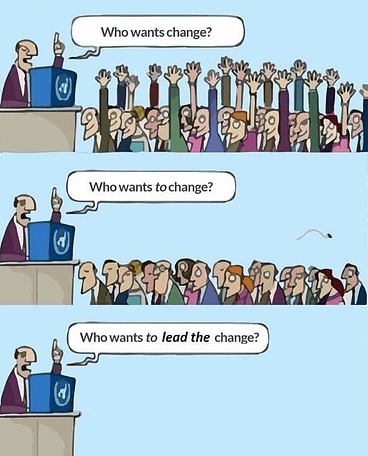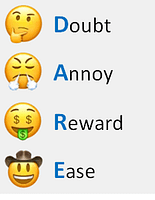Photo by Ross Findon on Unsplash
This article is part of a broader article on Change Management called The Caveman On Change Management.

We all know how tough change is. This is true for various reasons:
- Our brain puts more focus on not losing (something) vs. winning (something else). — Psychologists
- We are a species of habits. — Psychologists & biologists
- In adulthood, our ability to unlearn is more important than our ability to learn. — K
- Our subconscious brain prefers a known discomfort to an unknown comfort. — Neuro-Linguistic Programming
- …
Hence, oftentimes, a change endeavor creates an internal conflict between our rational self which understands the need for it and the auto-mode that wants to stick with current behavioral patterns.
Internal conflict is not the most productive strategy. What if we tricked ourselves instead?
That’s exactly what this article is about. It presents a simplified model based on the acronym DARE.

OK let’s go!
In the following paragraphs, I’ll develop the acronym DARE. Later I’ll propose an example to see it at work.
- Doubt: Confronting directly someone (including yourself) about a belief is a daunting task. Have you ever tried to convince a friend to change the soccer team s/he is a fan of?

So first you need to instill doubt about the currently established truths by pointing out:
. Risks & exceptions. Most rules (and beliefs) have exceptions, try to point them out. Don’t use assertions, that’s called arguing. Instead, use power questioning. It is more adapted.
. Differences in perception: a classic tool for that is the thinking hats technique. Try it out it works.
. Scenario planning is also a good way to unveil potential risks in a data-based manner.
These are propositions on how to instill Doubt about current established habits & beliefs. Now you need to…
- Annoy: to let go of old habits, make sure it is annoying to return to square zero: 1. announce the change, 2. install a feedback loop, 3. visualize the negative side effects of the status quo, and 4. use Differential Reinforcement. Said differently, it help people reach the PNR (Point of No Return) that is used in many areas of life, business, and war.

- Reward the desired behaviors. You can use positive reinforcement in all its forms: recognition, monetary, differential reinforcement (it works both ways ☺)… But nothing beats intrinsic motivation.

- Ease: Make it possible for people to adopt the desired new behaviors. Use levers like training, practice, delegation, ergonomics, automation…

OK, done with the explanation of each individual component of the DARE acronym now…
…Here is a not-so-fictional example
As I was managing a complex change management project, I got stuck with the attitude of the leadership team. Like most humans, they wanted a change but weren’t really willing to change. Remember the cartoon at the beginning of this article? 😉

And here is what we did:
- Doubt:
. We identified 2 occurrences where scenario planning will be a real mind-opener vs. the usual decision-making process. We did our homework and came up with a long list of hard-to-shake rationales. It played the trick;
. We customized a 360° questionnaire to the specific situation at hand and run the exercise. It opened new pathways of self-awareness like never before. - Annoy:
. We’ve defined the change: new culture, 5 strategic goals, and choices, KPIs…
. We’ve spotted the risks and worked on an action plan based on the model in the main article 🙂;
. We’ve committed to a deployment meeting date with all employees and stuck with it;
. We’ve designed a company communication system to fluidize information flow and collect feedback: regular team meetings, strategic planning meetings, quarterly meet-ups, employee engagement studies… - Reward:
. We’ve put in place a new bonus system that is exactly coherent with the new culture and strategy;
. We also took the opportunity of employee meet-ups to publicly recognize those who displayed desired behavior & attitude and called it the GM Award. - Ease: We made it as easy as possible to adopt the change by:
. Focusing on key elements that yield the most significant results. We combined the results of the model (Caveman on Change Management) & the 360° questionnaire referred to earlier to work on the most significant elements. Nothing more, nothing less.
. We’ve over-invested in training.
. I’ve run a few executive coaching sessions.
So to sum-up

As said earlier, you can use this on others or on yourself.
PS on ethics
I know some react negatively to tricks. So if you are interested in an actionable difference between manipulation and influence, read through.
If interested in learning how to work with your nature and not against it, check out my book at WorkWithYourNature.com
